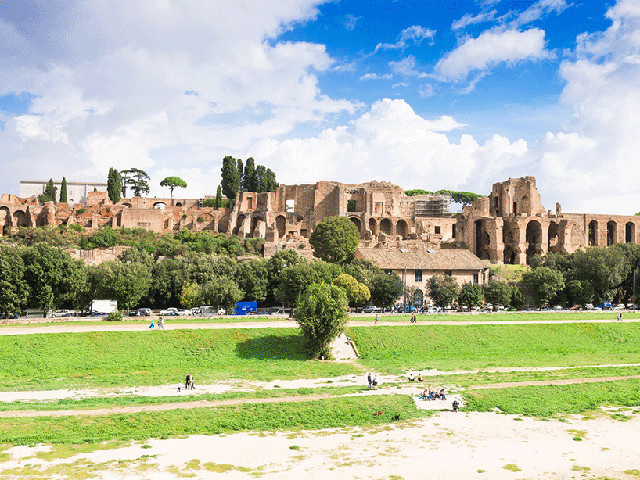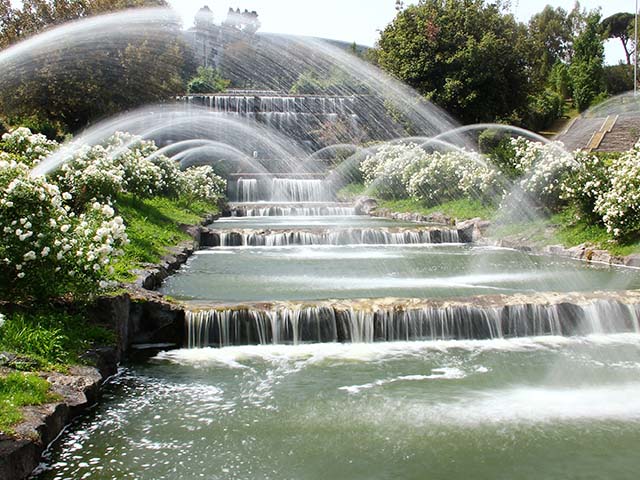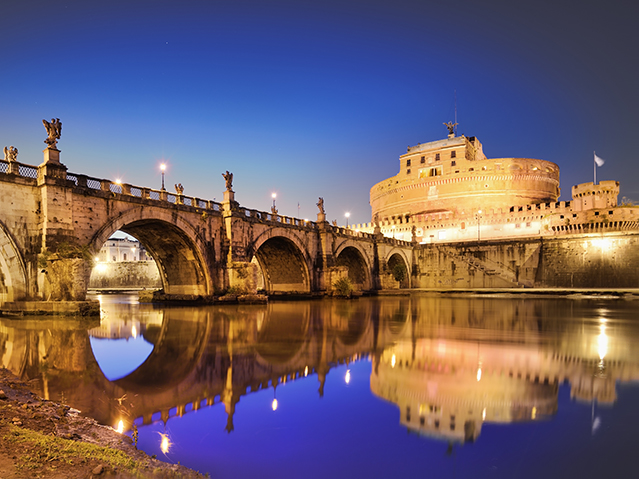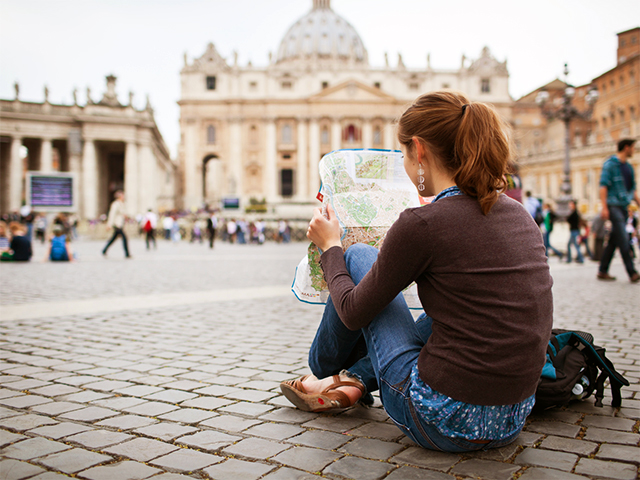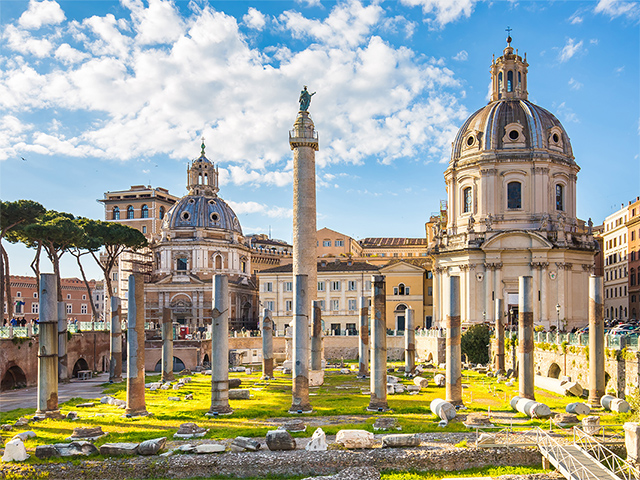The Pantheon of Rome
Everything about the wonderful Pantheon of Rome: history, architecture, description, opening hours and useful information about how to get there.Right in the center of Rome, not far from Piazza Navona, there is the majestic Pantheon, great monument that Michelangelo defined as work of angels and not of humans.
Just something to start with, what does Pantheon mean?
The name comes from the Greek words pan (all) and theon (god), and in fact, in its origins the Pantheon was a small temple devoted to all the gods.
BOOK YOUR GUIDED TOUR TO THE PANTHEON
PANTHEON: BETWEEN HISTORY AND LEGEND
Built between the 27 and the 25 BC by consul Agrippa, prefect of emperor Augustus, the Pantheon has been subject to many restoration works. After enduring well two fires, in the 80 and in the 110 AD, the temple was rebuilt as it can be seen today, from emperor Hadrian (128 AD) under whose reign of the Roman Empire reached the peak of its splendour.
Despite the fact that the current building is very different from the original temple, Hadrian wanted to honour consul Agrippa with the great Latin inscription that you can read on the façade:

Pantheon - The inscription in honor of consul Agrippa
"Marcus Agrippa, son of Lucius, made [this building] when consul for the third time."
There are many stories and legends circulating about the Pantheon. First of all, a legend linked to the place where the Pantheon is located. In fact, they say that it was right here where Romulus, the legendary founder of Rome, when he died, was grapped by an eagle and brought to heaven among the angels.
They also say that Cybele, ancient Greek godder venerated as Magna Mater, appeared in dreams to Agrippa to ask for the construction of the temple.
They even say that the oculus, the opening in the center of the dome, was created by the Devil when scaping from the temple of God.

The Pantheon and the beautiful fountain in Piazza della Rotonda, designed by Giacomo Della Porta
PANTHEON: ART AND ARCHITECTURE
The Pantheon is an architectural and engineering masterpiece. Among Rome's best preserved historic monuments, it has had great influence in all the Occidental architecture.
The temple is formed by a circular cella covered by an hemispherical dome, preceded by a pronaos of Greek origin with 16 Corinthian columns that hold the tympanum. Today, the tympanum is empty, but in Roman ages there was a bronze high relief representing the battle between giants and Amazons. Also the pronaos ceiling was made of bronze, but Pope Urban VIII in 1932 had it tore off to build another great work: the canopy of the altar made by Bernini, inside the Basilica of Saint Peter.
Once you have passed the large columns and the giant main entrance, also this made of bronce, unfolds before your eyes an architectural wonder. All of a sudden you will find yourself in this enormous empty space that will make your head spin and will make you feel very little. So you need to feel in the presence of the gods!
The most interesting and revolutionary thing is that the diameter of the interior circle of the dome is exactly the same than the height. Ideally extending the arching of the dome, you get a perfect sphere! You will feel so surrounded by the dome that you will seem to be suspended in the core of a big empty sphere.

A section of the project for the Pantheon
The dome is made mixing concrete and other materials, from travertine to pumice stone, lighter as getting closer to the top. This absolutely brilliant idea has allowed the dome of the Pantheon to resist almost 2,000 years and get to the present day perfectly intact.
Raising your eyes you will note that the only source of light is represented by an oculus, that is an opening placed at the zenith, 9 meters in diameter. The most important feature about the Pantheon is actually its relation with the light, which creates the space in the interior.
If you have the chance to enter in the temple by noon, when the light from the oculus is extraordinarily intense and it creates a really unique effect. Unlike all the temples in the past, that were built to be seen exclusively from the outside, the Pantheon turns this conception outside down.
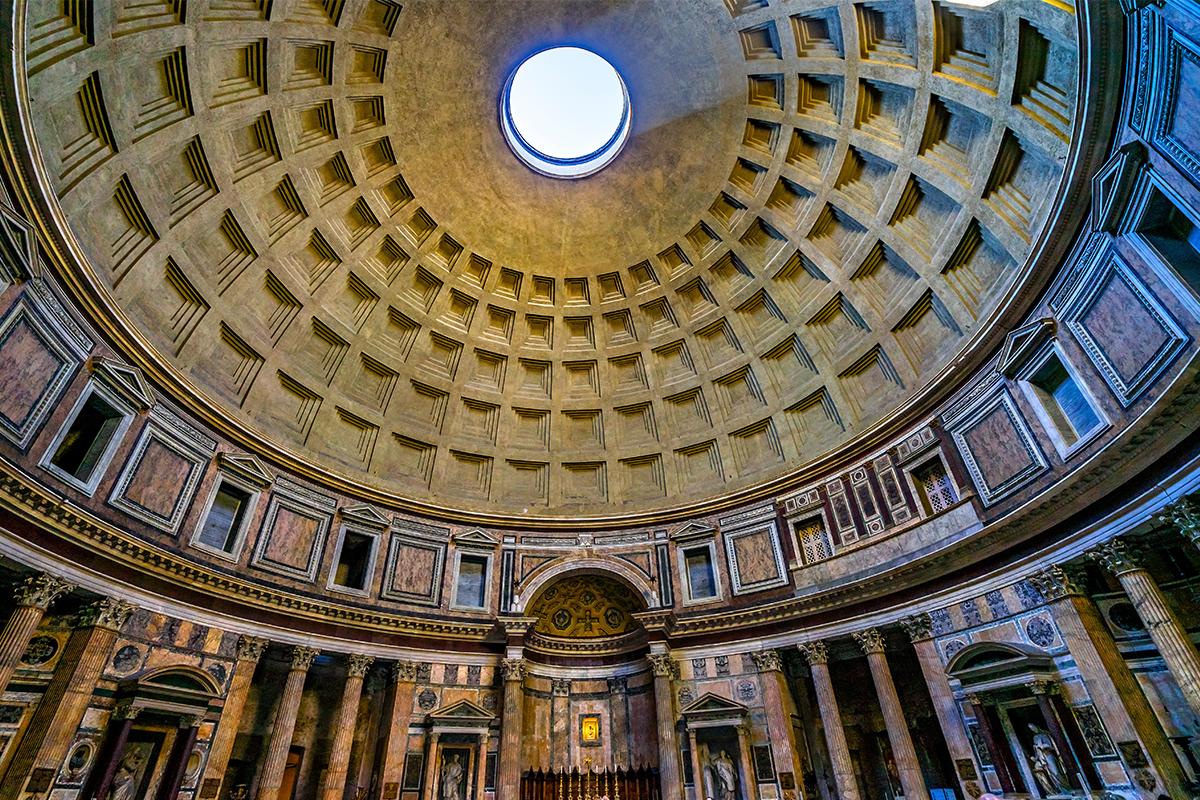
The striking perspective of the dome of the Pantheon with the light from the oculus
In the interior of the temple there are seven splendid niches, between two Corinthian columns, that were originally used to represent the seven gods related to the cult of the seven planets, namely the Sun, the Moon, Venus, Saturn, Jupiter, Mercure and Mars. When in early seventh century the Pantheon became a Christian basilica, some of them were used to build altars devoted to Christian martyrs.
The Basilica took then the name of Santa Maria della Rotonda or Santa Maria ad Martyres and in its interior are preserved the sepulchres of eminent personalities and artists like Annibale Caracci and Raffaello Sanzio. In addition, in January 1878, in the occasion of the death of the first King of Italydella morte del primo Re d'Italia Victor Emmanuel II, the Pantheon was chosen as resting place for the Kings of Italy. It currently hosts the remains of King Victor Emmanuel II, King Humberto I and Queen Margherita of Savoy.
Visiting the Pantheon is a unique experience! A simply wonderful work that encloses beauty, technique and harmony. An indispensable stop that you can't miss during your visit to the eternal city.
This article ends here... as always we await a number of your comments!
DISCOVER ALL PANTHEON TOURS
Useful information
Pantheon
- HOW TO GET THERE
From the Port of Civitavecchia: to get to the Pantheon, go to Civitavecchia Station and jump on the first train bound for Rome. After about one-hour trip, get off at Roma Termini Station. From there, take the subway (line A) and get off at Barberini. After about 450 meters by walk you will be there. Alternatively, in front of the station, in Piazza dei Cinquecento, you can take a bus to Largo di Torre Argentina.
From Rome: Take the subway (line A) and get off at Barberini. After about 450 meters by walk you will be there. Alternatively, you can take a bus. Lines 30, 40, 62, 64, 81, 87 and 492 take you to stop Largo di Torre Argentina, which is just 400 meters away from the Pantheon.
- TIMETABLES
- From Monday to Saturday: 9.00 - 19.30
Sunday: 9.00 - 18.00;
Holidays: 9.00 - 13.00Closing days: 25 December, 1 January and 1 May - PRICES
- Free admission**from May 2, 2018 to visit the Pantheon you will pay a €2 ticket.



 PORT MOBILITY CIVITAVECCHIA
PORT MOBILITY CIVITAVECCHIA








